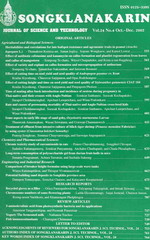ThaiScience
ThaiScience
SONGKLANAKARIN JOURNAL OF SCIENCE & TECHNOLOGY
Volume 42, No. 02, Month MARCH, Year 2020, Pages 406 - 414
Evaluation of enhanced bioremediation for soils contaminated with used lubricating oil in soil slurry system
Naruemon Meeboon and Suppasil Maneerat
Abstract Download PDF
This study was conducted to evaluate the biodegradability of used lubricating oil (ULO) in soil slurry system using bioaugmentation and biostimultion approaches. Bioaugmentation with SC9 consortium isolated from ULO-contaminated soil and biostimulation with biosurfactant obtained from Acinetobacter calcoaceticus subsp. anitratus SM7 as well as nutrients were investigated. Soil concentration, initial pH, type and concentration of nutrients, and inoculum size of SC9 consortium affected by the rate of microbial degradation of ULO in soil slurry system. Maximal degradation rate of ULO (63.3%) was obtained when SC9 consortia was incubated under the optimized conditions for 7 days. The maximum biodegradation and bacteria growth were 88.6% and 10.9 log CFUml-1 in unsterilized soil slurry supplemented with SC9 consortium and crude biosurfactant after 30 days of incubation. Biosurfactant derived from A. calcoaceticus subsp. anitratus SM7 and/or SC9 consortium are significant factors in supporting indigenous microbial growth and added to soils to enhance degradation of ULO in soil slurry bioremediation. Therefore, both SC9 consortium and biosurfactant have potential for apply in soil slurry bioremediation of ULO and other hydrocarbonscontaminated soil.
Keywords
biodegradation, biosurfactant, consortium, soil slurry, used lubricating oilSONGKLANAKARIN JOURNAL OF SCIENCE & TECHNOLOGY
Published by : Prince of Songkla University
Contributions welcome at : http://rdo.psu.ac.th
